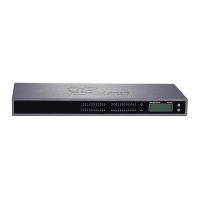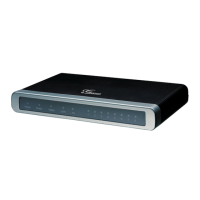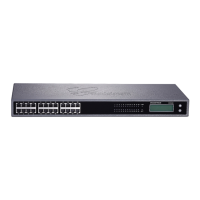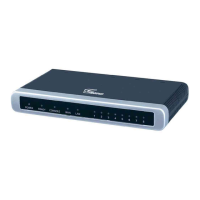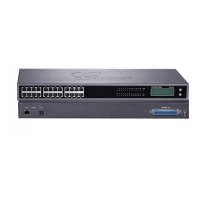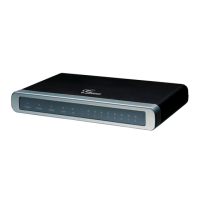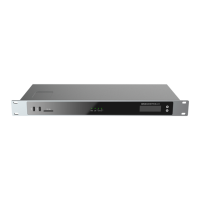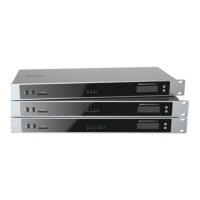Basic Settings
Clock
All E1/T1/J1 spans generate a clock signal on their transmit side. The parameter determines whether the clock signal from the f
end of the E1/T1/J1 is used as the master source of clock timing. If the far end is used as the master, the gateway system clock
synchronize to it.
Master: The port will never be used as a source of timing. This is appropriate when you know the far end should always be
slave to you.
Slave: The equipment at the far end of the E1/T1 link is the preferred source of the master clock.
Signaling
Chooses the signaling protocol that will be used on the digital port.
PRI: when one end is set to NET, the other end should be set to CPE
Data channel
Chooses the Data Channel for control.
The user can group multiple E1 lines with a single data channel.
Variant
MFC/R2 multinational adaption. GXW450X supports MFC/R2 standards by ITU and MFC/R2 standards in different countries or
regions including Argentina, Brazil, China, Czech Republic, Colombia, Ecuador, Indonesia, Mexico, the Philippines, and Venezue
TX Gain Configure the TX Gain for the transmitting channel of the digital port. The valid range is -24dB to +12dB.
Codec Select alaw or ulaw. If set to default, alaw will be used for E1.
Framing
If the span type is E1, the signaling configured as MFC/R2, then framing must configure as “cas”;
If the span type is E1, the signaling configured as PRI or SS7, then framing must configure as “ccs”;
If span type is T1, and the signaling configured as PRI or SS7, then framing can configure as “esf” or “d4”;
If span type is J1, and the signaling configured as PRI or SS7, then framing can configure as “esf” or “d4”.
CRC Validation For E1, select whether to use CRC4 or None.
Advanced Settings
Called Nature of Address Indicator
Indicates the type of the called number. The receiving switch may use this indicator during translations to apply the numb
proper dial plan. Users can select “Unknown”, “Subscriber”, “National”, “International” or “Dynamic”.
Calling Nature of Address Indicator
Indicates the type of the calling number. The receiving switch may use this indicator during translations to apply the num
proper dial plan. Users can select “Unknown”, “Subscriber”, “National”, “International” or “Dynamic”.
Orginal Called
This option decides on SS7 trunk outgoing calls,By controlling the "original called number IE" (Information Element) in
signaling messages, the user can ensure that the correct phone number is displayed to the recipient of a call, even when th
has been rerouted or redirected.
Example: if a call is routed through multiple networks or carriers, the "original called number" information can be lost or
modified along the way. However, by using this SS7 option, the user can preserve the original called number and ensure t
is displayed correctly to the recipient.
Disabled by Default.
Early ACM
Early ACM can be used to provide immediate feedback to callers that their call is being connected, as opposed to hearing
silence or ringing until the call is actually connected to the intended party. This can help to reduce perceived wait times an
improve the overall user experience.
If enabled, When an inbound call is received by the gateway, the gateway can signal to the calling party that the call is be
connected and that the called party will begin ringing. This early answer supervision signal is sent by the gateway before
called party's phone rings.
Disabled by Default.
International Prefix
National Prefix
Subscriber Prefix
Unknown Prefix
Configure the prefix in Called Nature of Address Indicator and Calling Nature of Address Indicator for each type.
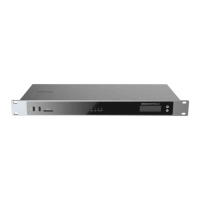
